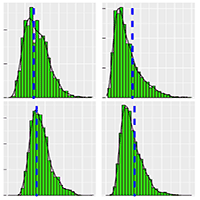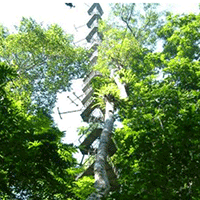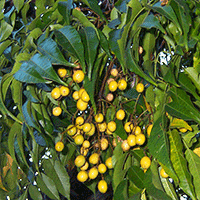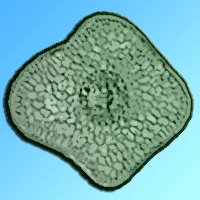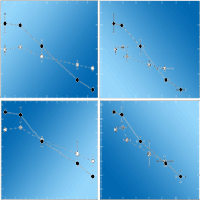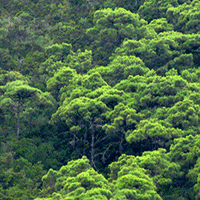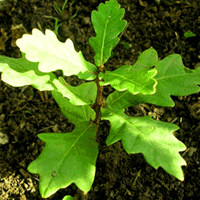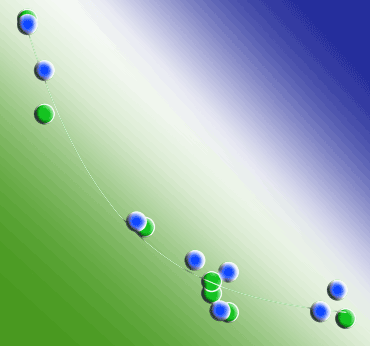With increasing concern for forest water use and anthropogenic alteration of forest structures, understanding the effects of structural changes in forests on transpiration is important. Our aim is to develop a stand transpiration model relating canopy conductance with stand sapwood area (SA) and environmental conditions for assessing the interannual variation in stand transpiration. The stand transpiration model is developed based on multiplicative empirical Gc estimations at eight Korean pine stands with different SAs. The model integrated the response of stomatal conductance to various environmental variables as vapor pressure deficit (D), photosynthetic active radiation (Q), air temperature (Ta), and soil water content (θ). The reference Gc (Gc at D=1kPa) and stomatal sensitivity to D was found to have a significant relationship with the SA, whereas other parameters like stomatal sensitivity to Q or Ta did not show significant relationships with it. The Gc model successfully reproduced changes in stand transpiration with changes in SA and climatic conditions. As this model uses SA, a simple and easily measurable structural variable, it can be easily applied to other Korean pine forests and can help estimate the spatial and temporal variations in stand transpiration.
Keywords
, , ,
Citation
Park J, Cho S, Moon M, Ryu D, Kim HS (2021). Developing stand transpiration model relating canopy conductance to stand sapwood area in a Korean pine plantation. iForest 14: 186-194. - doi: 10.3832/ifor3291-014
Academic Editor
Rossella Guerrieri
Paper history
Received: Nov 12, 2019
Accepted: Feb 08, 2021
First online: Apr 14, 2021
Publication Date: Apr 30, 2021
Publication Time: 2.17 months
© SISEF - The Italian Society of Silviculture and Forest Ecology 2021
Open Access
This article is distributed under the terms of the Creative Commons Attribution-Non Commercial 4.0 International (https://creativecommons.org/licenses/by-nc/4.0/), which permits unrestricted use, distribution, and reproduction in any medium, provided you give appropriate credit to the original author(s) and the source, provide a link to the Creative Commons license, and indicate if changes were made.

Breakdown by View Type
(Waiting for server response...)
Article Usage
Total Article Views: 34950
(from publication date up to now)
Breakdown by View Type
HTML Page Views: 29550
Abstract Page Views: 2662
PDF Downloads: 2180
Citation/Reference Downloads: 3
XML Downloads: 555
Web Metrics
Days since publication: 1701
Overall contacts: 34950
Avg. contacts per week: 143.83
Article Citations
Article citations are based on data periodically collected from the Clarivate Web of Science web site
(last update: Mar 2025)
Total number of cites (since 2021): 1
Average cites per year: 0.20
Publication Metrics
by Dimensions ©
Articles citing this article
List of the papers citing this article based on CrossRef Cited-by.
(1)
Bae SW, Jang SC, Lee KJ, Lee ST, Sung JH, Kim SH, Kim KH, Hwang JH, Kim JS, Jung JM, Kim HS (2011)Management strategy for integrity of Korean pine plantation. Research Report 11-11, Korean Forest Research Institute, Seoul, South Korea, pp. 19-20.
Gscholar
(2)
Benyon RG, Nolan RH, Hawthorn SN, Lane PN (2017)Stand-level variation in evapotranspiration in non-water-limited eucalypt forests. Journal of Hydrology 551: 233-244.
CrossRef |
Gscholar
(3)
Blanken PD, Black TA (2004)The canopy conductance of a boreal aspen forest, Prince Albert National Park, Canada. Hydrological Processes 18: 1561-1578.
CrossRef |
Gscholar
(4)
Buckley TN (2005)The control of stomata by water balance. New Phytologist 168: 275-292.
CrossRef |
Gscholar
(5)
Caldwell PV, Miniat CF, Elliott KJ, Swank WT, Brantley ST, Laseter SH (2016)Declining water yield from forested mountain watersheds in response to climate change and forest mesophication. Global Change Biology 22: 2997-3012.
CrossRef |
Gscholar
(6)
Cosme LH, Schietti J, Costa FR, Oliveira RS (2017)The importance of hydraulic architecture to the distribution patterns of trees in a central Amazonian forest. New Phytologist 215: 113-125.
CrossRef |
Gscholar
(7)
Duursma RA, Kolari P, Perämäki M, Nikinmaa E, Hari P, Delzon S, Loustau D, Ilvesniemi H, Pumpanen J, Mäkelä A (2008)Predicting the decline in daily maximum transpiration rate of two pine stands during drought based on constant minimum leaf water potential and plant hydraulic conductance. Tree Physiology 28: 265-276.
CrossRef |
Gscholar
(8)
Ewers BE, Gower ST, Bond-Lamberty B, Wang CK (2005)Effects of stand age and tree species on canopy transpiration and average stomatal conductance of boreal forests. Plant Cell and Environment 28: 660-678.
CrossRef |
Gscholar
(9)
Ewers BE, Mackay DS, Tang J, Bolstad PV, Samanta S (2008)Intercomparison of sugar maple (
Acer saccharum Marsh.) stand transpiration responses to environmental conditions from the Western Great Lakes Region of the United States. Agricultural and Forest Meteorology 148: 231-246.
CrossRef |
Gscholar
(10)
Gao Q, Zhao P, Zeng X, Cai X, Shen W (2002)A model of stomatal conductance to quantify the relationship between leaf transpiration, microclimate and soil water stress. Plant, Cell and Environment 25: 1373-1381.
CrossRef |
Gscholar
(11)
Gash JHC, Shuttleworth WJ, Lloyd CR, André JC, Goutorbe JP, Gelpe J (1989)Micrometeorological measurements in Les Landes Forest during HAPEX-MOBILHY. Agricultural and Forest Meteorology 46: 131-147.
CrossRef |
Gscholar
(12)
Granier A (1987)Evaluation of transpiration in a Douglas-fir stand by means of sap flow measurements. Tree Physiology 3: 309-320.
CrossRef |
Gscholar
(13)
Granier A, Biron P, Lemoine D (2000a)Water balance, transpiration and canopy conductance in two beech stands. Agricultural and Forest Meteorology 100: 291-308.
CrossRef |
Gscholar
(14)
Granier A, Loustau D, Breda N (2000b)A generic model of forest canopy conductance dependent on climate, soil water availability and leaf area index. Annals of Forest Science 57: 755-765.
CrossRef |
Gscholar
(15)
Harris PP, Huntingford C, Cox PM, Gash JH, Malhi Y (2004)Effect of soil moisture on canopy conductance of Amazonian rainforest. Agricultural and Forest Meteorology 122: 215-227.
CrossRef |
Gscholar
(16)
Herbst M (1995)Stomatal behaviour in a beech canopy: an analysis of Bowen ratio measurements compared with porometer data. Plant, Cell and Environment 18: 1010-1018.
CrossRef |
Gscholar
(17)
Herbst M, Rosier PT, Morecroft MD, Gowing DJ (2008)Comparative measurements of transpiration and canopy conductance in two mixed deciduous woodlands differing in structure and species composition. Tree Physiology 28: 959-970.
CrossRef |
Gscholar
(18)
Hornbeck J, Adams M, Corbett E, Verry E, Lynch J (1993)Long-term impacts of forest treatments on water yield: a summary for northeastern USA. Journal of Hydrology 150: 323-344.
CrossRef |
Gscholar
(19)
Jarvis P (1976)The interpretation of the variations in leaf water potential and stomatal conductance found in canopies in the field. Philosophical Transactions of the Royal Society of London B: Biological Sciences 273: 593-610.
CrossRef |
Gscholar
(20)
Jarvis P, McNaughton K (1986)Stomatal control of transpiration: scaling up from leaf to region. In: “Advances in Ecological Research”, vol. 15, Elsevier, pp. 1-49.
CrossRef |
Gscholar
(21)
Kelliher FM, Leuning R, Schulze ED (1993)Evaporation and canopy characteristics of coniferous forests and grasslands. Oecologia 95: 153-163.
CrossRef |
Gscholar
(22)
Kim HS, Oren R, Hinckley TM (2008)Actual and potential transpiration and carbon assimilation in an irrigated poplar plantation. Tree Physiology 28: 559-577.
CrossRef |
Gscholar
(23)
Klein T, Cohen S, Yakir D (2011)Hydraulic adjustments underlying drought resistance of
Pinus halepensis. Tree Physiology 31: 637-648.
CrossRef |
Gscholar
(24)
Komatsu H, Kang Y, Kume T, Yoshifuji N, Hotta N (2006)Transpiration from a
Cryptomeria japonica plantation, part 2: responses of canopy conductance to meteorological factors. Hydrological Processes 20: 1321-1334.
CrossRef |
Gscholar
(25)
Komatsu H, Shinohara Y, Kumagai T, Kume T, Tsuruta K, Xiang Y, Ichihashi R, Tateishi M, Shimizu T, Miyazawa Y, Nogata M, Laplace S, Han T, Chiu CW, Ogura A, Saito T, Otsuki K (2014)A model relating transpiration for Japanese cedar and cypress plantations with stand structure. Forest Ecology and Management 334: 301-312.
CrossRef |
Gscholar
(26)
Kumagai T, Tateishi M, Shimizu T, Otsuki K (2008)Transpiration and canopy conductance at two slope positions in a Japanese cedar forest watershed. Agricultural and Forest Meteorology 148: 1444-1455.
CrossRef |
Gscholar
(27)
Medhurst JL, Beadle C (2002)Sapwood hydraulic conductivity and leaf area - Sapwood area relationships following thinning of a
Eucalyptus nitens plantation. Plant, Cell and Environment 25 (8): 1011-1019.
CrossRef |
Gscholar
(28)
Medhurst JL, Battaglia M, Beadle CL (2002)Measured and predicted changes in tree and stand water use following high-intensity thinning of an 8-year-old
Eucalyptus nitens plantation. Tree Physiology 22: 775-784.
CrossRef |
Gscholar
(29)
Moon M, Kim T, Park J, Cho S, Ryu D, Kim HS (2015)Variation in sap flux density and its effect on stand transpiration estimates of Korean pine stands. Journal of Forest Research 20: 85-93.
CrossRef |
Gscholar
(30)
Moon M, Kim T, Park J, Cho S, Ryu D, Suh S, Kim HS (2016)Changes in spatial variations of sap flow in Korean pine trees due to environmental factors and their effects on estimates of stand transpiration. Journal of Mountain Science 13: 1024-1034.
CrossRef |
Gscholar
(31)
Novick K, Oren R, Stoy P, Juang JY, Siqueira M, Katul G (2009)The relationship between reference canopy conductance and simplified hydraulic architecture. Advances in Water Resources 32: 809-819.
CrossRef |
Gscholar
(32)
Oren R, Sperry JS, Ewers BE, Pataki DE, Phillips N, Megonigal JP (2001)Sensitivity of mean canopy stomatal conductance to vapor pressure deficit in a flooded
Taxodium distichum L. forest: hydraulic and non-hydraulic effects. Oecologia 126: 21-29.
CrossRef |
Gscholar
(33)
Oren R, Sperry JS, Katul G, Pataki DE, Ewers B, Phillips N, Schäfer K (1999)Survey and synthesis of intra-and interspecific variation in stomatal sensitivity to vapour pressure deficit. Plant, Cell and Environment 22: 1515-1526.
CrossRef |
Gscholar
(34)
Poyatos R, Martínez-Vilalta J, Cermák J, Ceulemans R, Granier A, Irvine J, Köstner B, Lagergren F, Meiresonne L, Nadezhdina N (2007a)Plasticity in hydraulic architecture of Scots pine across Eurasia. Oecologia 153: 245-259.
CrossRef |
Gscholar
(35)
Poyatos R, Villagarcía L, Domingo F, Piñol J, Llorens P (2007b)Modelling evapotranspiration in a Scots pine stand under Mediterranean mountain climate using the GLUE methodology. Agricultural and Forest Meteorology 146: 13-28.
CrossRef |
Gscholar
(36)
R Core Team (2016)R: a language and environment for statistical computing. R Foundation for Statistical Computing, Vienna, Austria.
Online |
Gscholar
(37)
Rodrigues TR, Vourlitis GL, Lobo F, Santanna FB, De Arruda PH, Nogueira J (2016)Modeling canopy conductance under contrasting seasonal conditions for a tropical savanna ecosystem of south central Mato Grosso, Brazil. Agricultural and Forest Meteorology 218: 218-229.
CrossRef |
Gscholar
(38)
Roman D, Novick K, Brzostek E, Dragoni D, Rahman F, Phillips R (2015)The role of isohydric and anisohydric species in determining ecosystem-scale response to severe drought. Oecologia 179: 641-654.
CrossRef |
Gscholar
(39)
Ryu D, Moon M, Park J, Cho S, Kim T, Kim HS (2014)Development of allometric equations for V age-class
Pinus koraiensis in Mt. Taehwa plantation Gyeonggi-do. Korean Journal of Agricultural and Forest Meteorology 16 (1): 29-38.
CrossRef |
Gscholar
(40)
Schäfer K, Oren R, Tenhunen J (2000)The effect of tree height on crown level stomatal conductance. Plant, Cell and Environment 23: 365-375.
CrossRef |
Gscholar
(41)
Shibuya M, Hasaba H, Yajima T, Takahashi K (2005)Effect of thinning on allometry and needle-age distribution of trees in natural
Abies stands of northern Japan. Journal of Forest Research 10: 15-20.
CrossRef |
Gscholar
(42)
Simonin K, Kolb T, Montes-Helu M, Koch G (2007)The influence of thinning on components of stand water balance in a ponderosa pine forest stand during and after extreme drought. Agricultural and Forest Meteorology 143: 266-276.
CrossRef |
Gscholar
(43)
Tanaka K, Kosugi Y, Nakamura A (2002)Impact of leaf physiological characteristics on seasonal variation in CO
2, latent and sensible heat exchanges over a tree plantation. Agricultural and Forest Meteorology 114: 103-122.
CrossRef |
Gscholar
(44)
Tang J, Bolstad PV, Ewers BE, Desai AR, Davis KJ, Carey EV (2006)Sap flux-upscaled canopy transpiration, stomatal conductance, and water use efficiency in an old growth forest in the Great Lakes region of the United States. Journal of Geophysical Research: Biogeosciences 111 (G2): 1-12.
CrossRef |
Gscholar
(45)
Tor-ngern P, Oren R, Oishi AC, Uebelherr JM, Palmroth S, Tarvainen L, Ottosson-Löfvenius M, Linder S, Domec JC, Näsholm T (2017)Ecophysiological variation of transpiration of pine forests: synthesis of new and published results. Ecological Applications 27: 118-133.
CrossRef |
Gscholar
(46)
Turnbull MH, Whitehead D, Tissue DT, Schuster WS, Brown KJ, Engel VC, Griffin KL (2002)Photosynthetic characteristics in canopies of
Quercus rubra, Quercus prinus and
Acer rubrum differ in response to soil water availability. Oecologia 130: 515-524.
CrossRef |
Gscholar
(47)
Vertessy RA, Watson FGR, O’Sullivan SK (2001)Factors determining relations between stand age and catchment water balance in mountain ash forests. Forest Ecology and Management 143: 13-26.
CrossRef |
Gscholar
(48)
Wang H, Zhao P, Zou L, McCarthy H, Zeng X, Ni G, Rao X (2014)CO
2 uptake of a mature
Acacia mangium plantation estimated from sap flow measurements and stable carbon isotope discrimination. Biogeosciences 11: 1393.
Gscholar
(49)
Wang Y, Papanatsiou M, Eisenach C, Karnik R, Williams M, Hills A, Lew VL, Blatt MR (2012)Systems dynamic modeling of a guard cell Cl- channel mutant uncovers an emergent homeostatic network regulating stomatal transpiration. Plant Physiology 160: 1956-1967.
CrossRef |
Gscholar
(50)
Zhang L, Zhou T (2015)Drought over East Asia: a review. Journal of Climate 28: 3375-3399.
CrossRef |
Gscholar


